Scotland is a country full of history, from the ancient castles to the kings and queens that called them home. When you visit Scotland, visiting the ancient castles must be on your bucket list. On our NC500 roadtrip, we made it our aim to visit as many of the castles around the NC500 route as we could and learn about history.
One of our favourite castles on the NC500 being Castle Sinclair Girnigoe, ruins that sit on the east coast of Caithness.
No time to read now? No problem, save a pin to your Pinterest board for later!

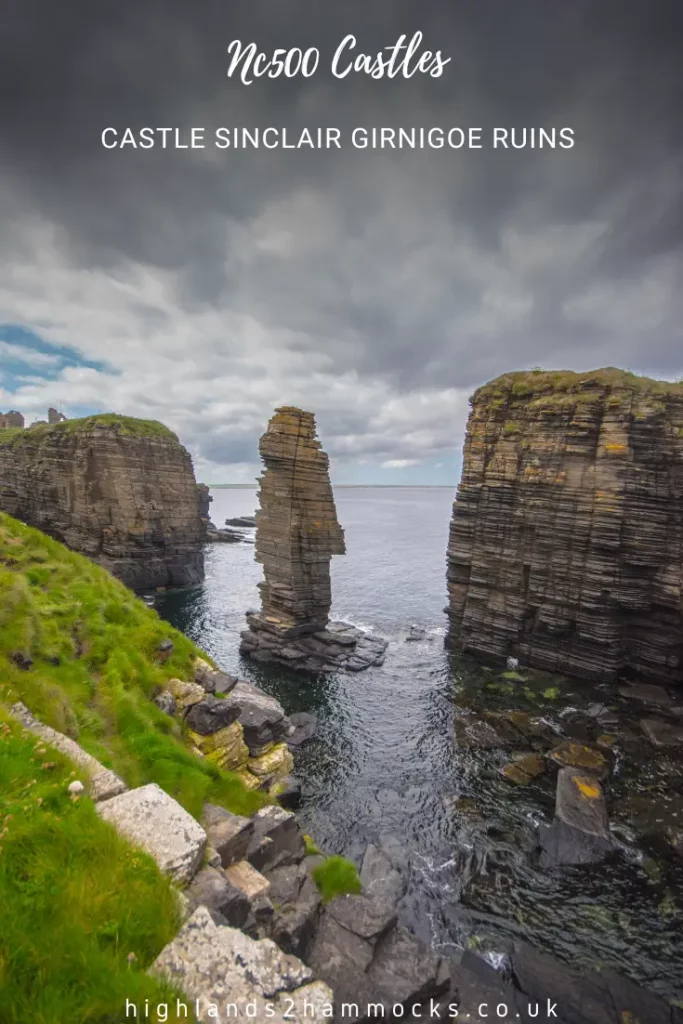
Castle Sinclair Girnigoe Ruins, NC500
This guide to Castle Sinclair Girnigoe covers the history of these ruins as well as how to get there and also includes the following information:
Table of Contents
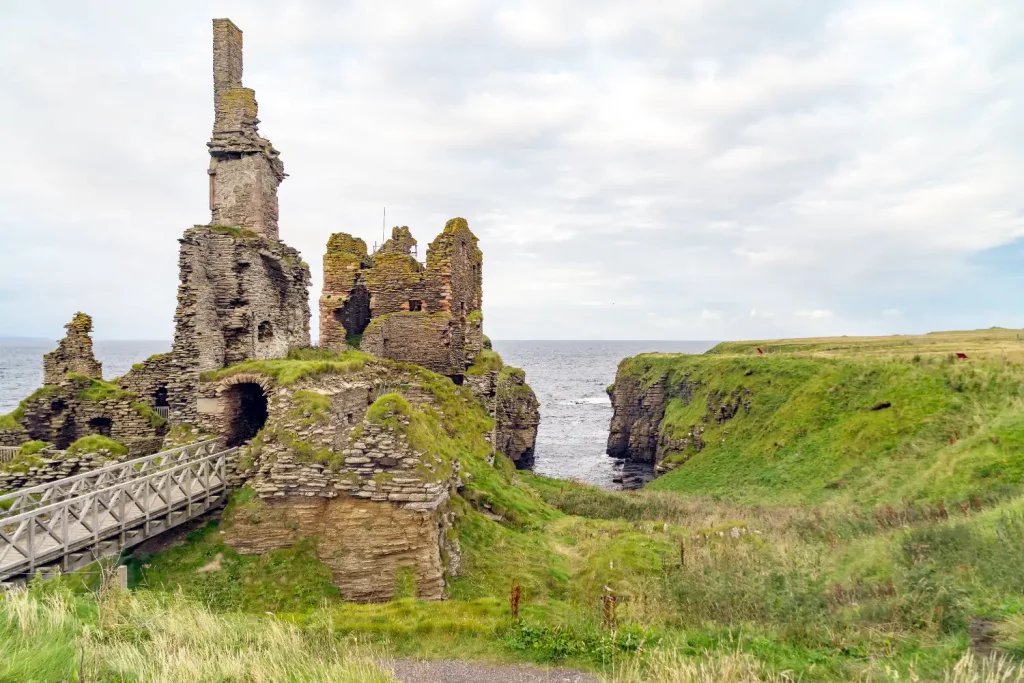
Where to Stay on the North Coast 500
There is a wide range of accommodations around the NC500 route, so you will not be short on options. Depending on how long you are spending in each area will depend on how long you spend in that location. It is worth bearing in mind that some accommodations will require you to stay a minimum number of nights so it is worth researching this when you are planning your North Coast 500 itinerary.
Our new book North Coast 500 Where to Eat and Stay shares the best places to eat and stay around the NC500 and includes whether places are dog friendly, accessible, have wifi and EVC ad whether they cater to dietary requirements. This paired with our own Destination Nc500 is the perfect NC500 combo package for planning your trip.
The remoteness in the highlands of Scotland will leave you with little choice of accommodation in each location along the NC500, however, there are still enough options to choose from to ensure a comfortable trip. These are mostly in the shape of B&Bs, Airbnbs, converted cottages and other quirky accommodations.
Planning Your Trip
We use the below booking platforms to plan our trips. We hope you find them useful too!
NC500 Motorhome and Campervan Scheme
The NC500 Motorhome Scheme, officially known as the Highland Campervan and Motorhome Scheme, was launched by the Highland Council on July 1, 2024. This innovative initiative is designed to address the growing number of motorhomes and campervans traveling along the popular North Coast 500 (NC500) route, ensuring that their impact on the local environment and communities is managed sustainably.
The scheme offers a voluntary seven-day pass costing £40, inclusive of VAT. This pass grants motorhome and campervan users access to 12 designated overnight parking locations along the NC500 route, including scenic spots like Torvean Car Park in Inverness, Nairn Harbour, Dunnet Head Car Park, and Ullapool Latheron Car Park.
These parking spots are available on a first-come, first-served basis from 10 PM to 8 AM, with a 72-hour no-return policy at each location. This ensures that the facilities are used responsibly and that a larger number of travellers can benefit from them.
Overall, the NC500 Motorhome Scheme provides a structured and sustainable approach to motorhome travel in one of Scotland’s most scenic and popular areas. We think this is a great idea and encourage everyone to take advantage of it if you are looking to explore this road trip soon.
Read all about this new scheme in our complete guide to the NC500 Motorhome Scheme here.
For more information or to purchase a membership, travellers can visit the Highland Council’s official website.
What is Castle Sinclair Girnigoe
One of Scotland’s most ancient castles lies high up on the northern coast of Scotland, just south of the town of John O’Groats. Castle Sinclair Girnigoe dates back more than 500 years and features a truly turbulent history involving gruesome battles and changing ownership.
Development of the huge castle happened over a span of 300 years of occupation until it was finally abandoned and left to the harsh elements of the north of Scotland. Visit this beautiful castle ruin on your trip around the North Coast 500 and discover one of the most dramatic castles of the NC500.
What is the History of Castle Sinclair Girnigoe?
The largest castle ruins on the Nc500 are the cliffside wonders of Castle Sinclair and Castle Girnigoe. The 15th century Castle Girnigoe and 17th century Castle Sinclair are believed to be one of the earliest seats of Clan Sinclair. Located around 3 miles north of Wick, these ruins are the most spectacular ruins you will find on the NC500.
Perched on the side of the cliff, these castles hold a fascinating historical tale. The structure was constructed between 1476 and 1606, with adaptions made to them spanning some 100 years. Throughout this time, these castles remained occupied by either Sinclair or Campbell, with ownership passing between the two. Occupation of this castle came to an end in 1680 when a siege to Castle Sinclair and Girnigoe saw it damaged so badly, it was never inhabited again.
This castle site is free entry, although there is a donation box on the gate. Reconstruction of the ruins aims to make Castle Sinclair the first castle on the North Coast 500 to be wheelchair accessible. By donating whatever you can to this cause, we can ensure everyone will have the opportunity to enjoy the beauty of Scotland.
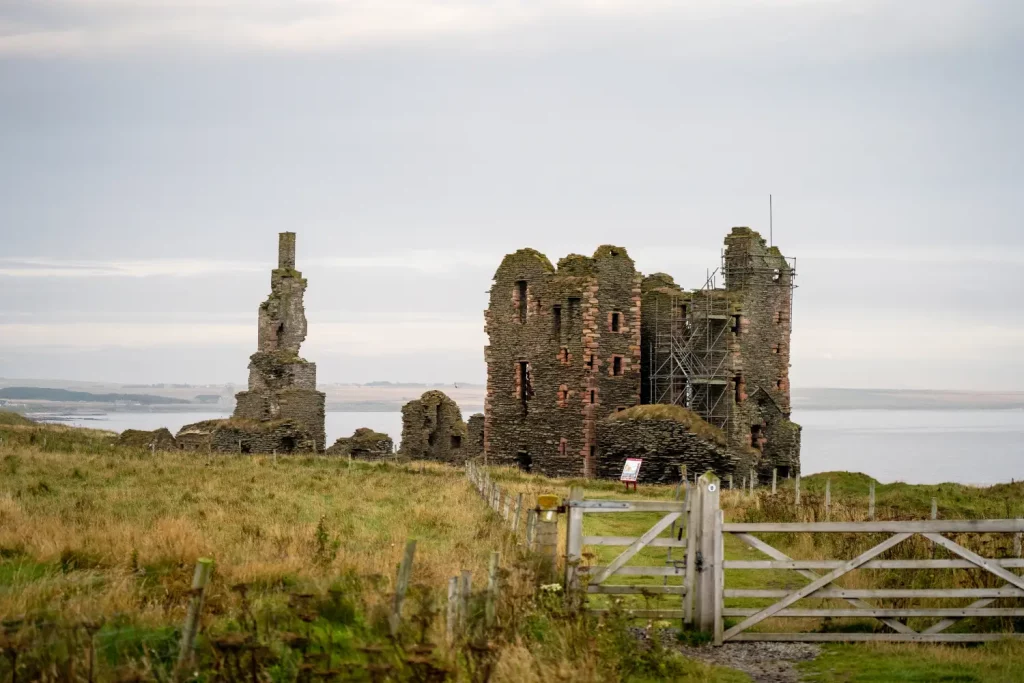
Where is Castle Sinclair Girnigoe?
Castle Sinclair and Castle Girnigoe are located on the cliffside 3 miles north of the town of Wick on the east coast of Caithness in Scotland. It is the perfect stop off on a North Coast 500 road trip.
Located on the north coast of Scotland and overlooking the North Sea, the castles were exposed to harsh coastal weather conditions, resulting in erosion that has been threatening to destroy the castle. The Clan Sinclair Trust charity has been set up to maintain and repair the castle over the years to ensure it is safe and accessible for visitors to experience.
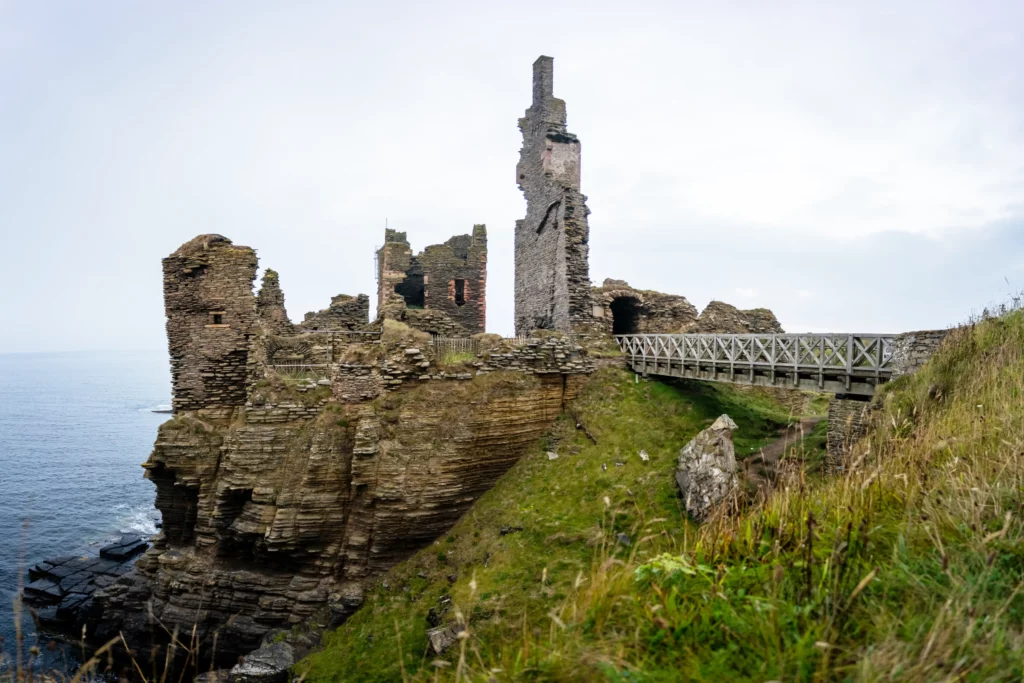
How to get to Castle Sinclair and Castle Girnigoe?
To get to Castle Sinclair and Castle Girnigoe, head through the town of Wick and follow the signs for Staxigoe, heading east. Follow the signs for Castle Sinclair and Castle Girnigoe where you will come across a large car park. You will see the castles sitting in the distance, around a 5-minute walk away. Follow the path towards the castle, where there is a donation box as you cross the gate.

Why Should I go to Castle Sinclair and Castle Girnigoe?
Visiting Castle Sinclair and Castle Girnigoe allows you to learn a lot about the history in Scotland. It is also a great opportunity to visit a castle ruin in the north of Scotland. Many castles you will need to pay entry into to visit, however, Castle Sinclair and Castle Girnigoe are donation-based and you can still explore around the ruins.
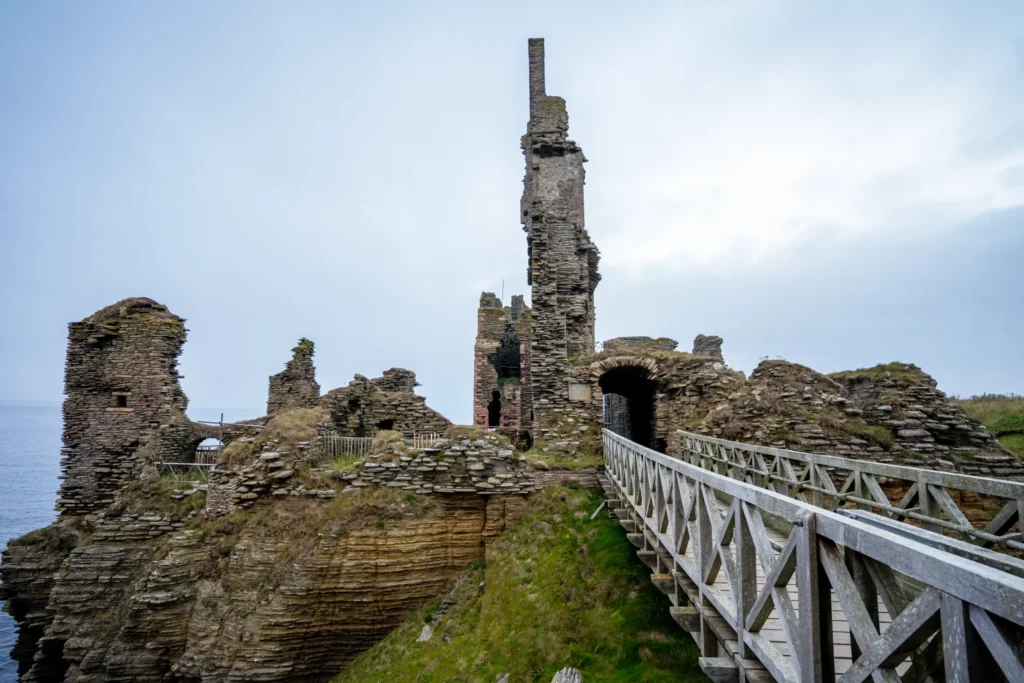
When Should I go to Castle Sinclair and Castle Girnigoe?
Due to the potentially harsh and ever-changing weather conditions that can be expected in the winter months in Scotland. We would recommend a trip to Castle Sinclair and Castle Girnigoe in the summer months. That way it will be a lot more enjoyable to explore the ruins than worrying about the freezing and most likely wet weather conditions.
Nearby Sights to Castle Sinclair Girnigoe
There are loads of other beautiful sights on the NC500 that you will need to visit close by to Castle Sinclair Girnigoe, both to the west and further to the south.
Visit the Duncansby Stacks
Towering above the ferocious North Sea are the beautiful and majestic outlines of the Duncansby Stacks. Standing as a testament to the power of nature in this remote part of the world, it is believed that these sea stacks have existed for over 6000 years, slowly being eroding by the strength of the sea.
During your trip around the NC500, swing by Duncansby Head and visit the lighthouse that dates back to 1924, and wander along the coast to see these impressive sea columns for yourself.
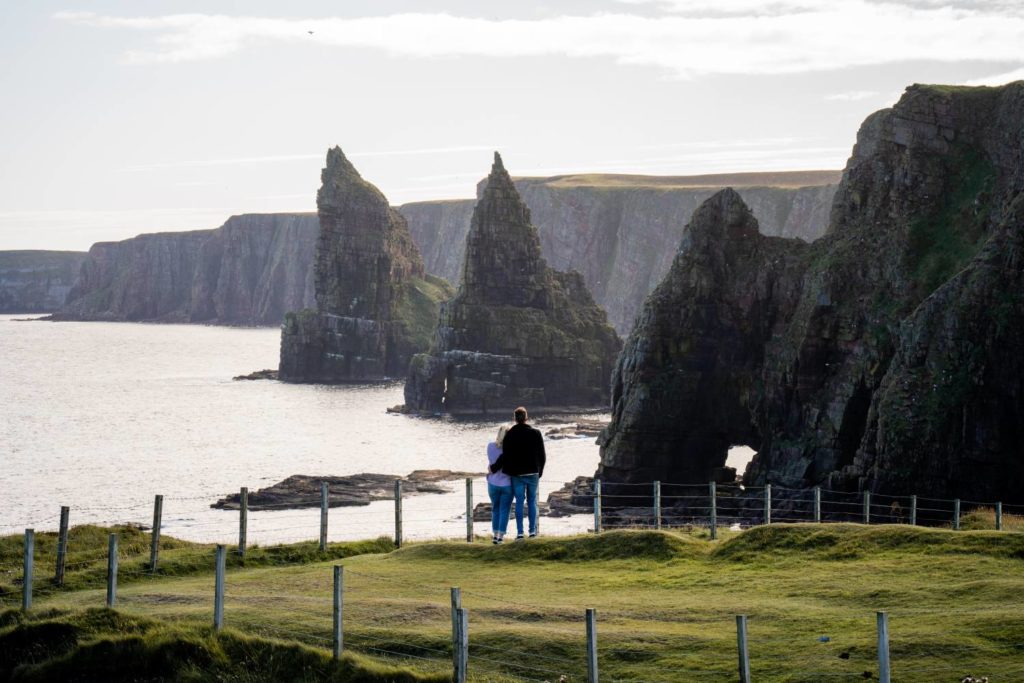
Castle of Old Wick
This was one of our favourite castle stops, believed to have been built in the 1100’s. This castle dates back to the days when the Norwegian Earldom of Orkney included Caithness. There is even evidence of occupation of this land dating back before the structure you see today was built. This castle ruin is free to enter.
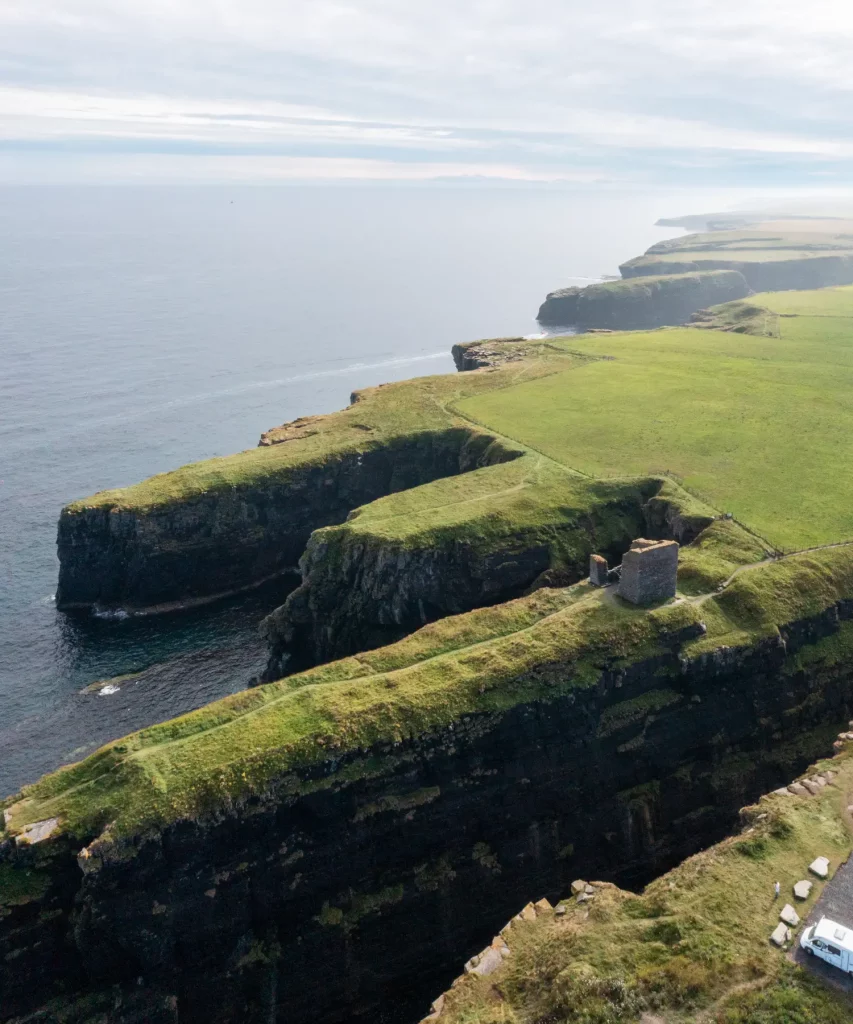
John O’Groats Sign post
The most famous sight in the northern coast of Scotland and end of the countrywide, 874-mile trail from Lands End to John O’ Groats is the famous landmark signpost marking the end of the road. This signpost is one of the most photographed signposts in the world and draws thousands of visitors every single year, all eager to capture a picture at the edge of the world.
The sign that you visit today is actually a replacement of the original, which was installed in 1964 on private land and required a fee to have a photo taken beside it. In 2013 the original site was bought as part of a hotel renovation project, and upon completion, a new sign was installed in the original location available to public access.
If you wish to view the original and have your picture taken with customisable text on the sign, you can do so at the John O’Groats Caravan Park 180m from the original site.
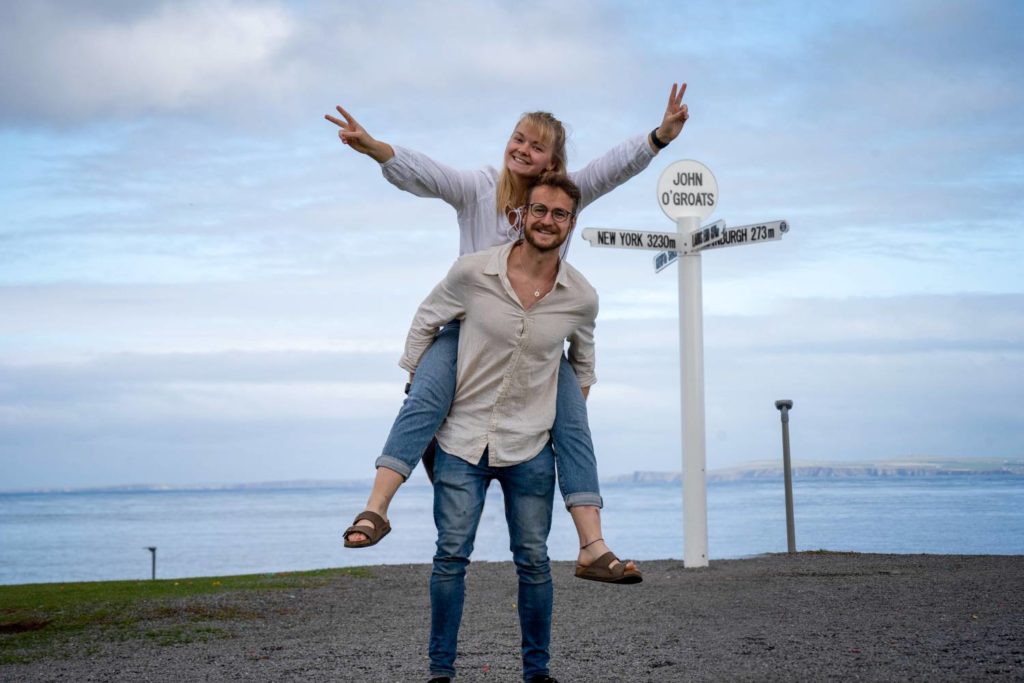
Before You Leave on the North Coast 500
Before you head off on your trip around the NC500, there are certain things you will need to get organised to ensure a smooth trip. These include how to get around the route, including being aware of single track roads, etc., what to pack for Scotland, where to stay along the route and what travel insurance to book.
How Do I Get Around?
Given the remote location of the NC500 and the majority of the sights along the route, the best way to get around this road trip is by driving. There are of course other methods that are still popular, such as cycling and hiking, however, if you have a short amount of time on the route, neither of these are very suitable.
As for public transport, the use around the NC500 is understandably difficult due to how remote each location is, however, with the increasing problem of congestion along the route, this is a good option to research if you have time. If it is something that interests you, you can read a public formed itinerary of how to get around the NC500 by public transport over here.
If you are looking to rent a cosy, reliable and luxurious campervan for your trip along the NC500, we highly recommend hiring through Bunk Campers. We toured with these guys around the up-and-coming Heart 200 road trip in Scotland’s central highlands and could not believe the comfort and customer service we experienced with their vans.
Browse the full range of vehicles on offer at Bunk Campers over here.
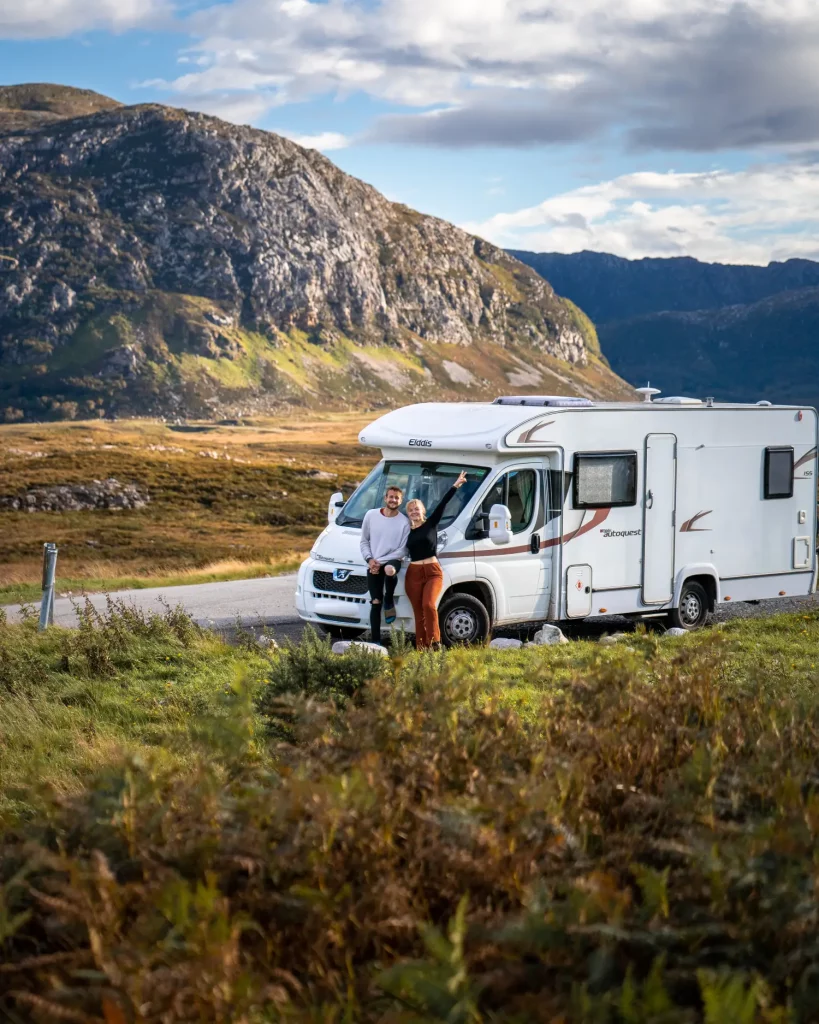
Where to Stay on the NC500
There is a wide range of accommodations around the NC500 route, so you will not be short on options. Depending on how long you are spending in each area will depend on how long you spend in that location. It is worth bearing in mind that some accommodations will require you to stay a minimum number of nights so it is worth researching this when you are planning your North Coast 500 itinerary.
Our new book North Coast 500 Where to Eat and Stay shares the best places to eat and stay around the NC500 and includes whether places are dog friendly, accessible, have wifi and EVC ad whether they cater to dietry requirements.
The remoteness in the highlands of Scotland will leave you with little choice of accommodation in each location along the NC500, however, there are still enough options to choose from to ensure a comfortable trip. These are mostly in the shape of B&Bs, Airbnbs, converted cottages and other quirky accommodations.
Depending on how adventurous you are, there may be more accommodation choices than just the above, often with an even better view. Caravan and camping sites are abundant along the NC500, drawing camping enthusiasts from all over the world. For some of the most spectacular bedside scenery along the North Coast 500, we recommend packing a tent and getting in touch with nature for the week.
As we travelled along the North Coast 500, camped in our trusty Vango tent on a mixture of campsites and wild sites. Wild camping is a fantastic way to enjoy the beauty of the highlands, however, it must be done respectfully. Read our full guide to Wild Camping if you wish to give it a go so you know everything you need to for a comfortable and sustainable trip.

What Should I Pack?
When it comes to packing for a trip to Scotland there is one item of clothing that you are going to need all year round: a waterproof. It rains in Scotland on average 250 days a year, meaning that during your 5-day Heart 200 road trip you will probably experience at least a drizzle of rain. Due to this, the number one item on any Scotland packing list is a good waterproof jacket.
As for the rest of the year, the temperature in Scotland and the central heartlands is reasonably mild for most of the year. During the winter months, you will most likely experience snow, however, temperatures usually sit around freezing, so it is not too cold. For your reference, the average temperatures in Scotland are listed below during each season.
Spring (March, April, May) – 5-10 degrees C
Summer (June, July, August) – 15 degrees C
Autumn (September, October, November) – 5-10 degrees C
Winter (December, January, February) – 0-5 degrees C
As you can see, the weather never really gets above the teens, with anything over 25 degrees C considered a heatwave. The best way to pack for your trip to the highlands is with layers that can be added and removed as you need them. You will definitely need a hat and gloves during the colder months and will most likely need sunscreen to protect you on the long days in the open.
We would also recommend taking our NC500 guidebooks with you on your journey. This will help you plan your itinerary and ensure that you don’t miss out on any of the best places to go on the NC500. Our Destination NC500 guidebook is well paired with NC500 Where to Eat and Stay and you can buy the combo here.
Given the beautiful sights and scenery that you are no doubt going to see around Scotland, we highly recommend packing a good camera for your trip. If you want to read more about the cameras we use and why we love them, check out the link below.
Photography Equipment
Main Photography Camera – Sony A7v Mirrorless Camera and Sony A7iii Mirrorless Camera
Microphone – Sony Mic ECM-B1M
Main Lens – Tamron 17-28mm f/2.8
Zoom Lens – Tamron 70-180mm f/2.8
Camera Tripod – ZOMEI Z669C Camera Tripod
Gorilla Pod – JOBY JB01507-BWW GorillaPod
Action Camera – GoPro Hero 11 and Insta 360 One RS
Drone Camera – DJI Mavic Pro 3
Camera Bag – Wandrd PRVKE 41L and The Nest by Tropicfeel
Phone Tripod – Manfrotto MKPIXICLAMP-BK, Mini Tripod with Universal Smartphone Clamp
Sturdy Phone Tripod & Selfie Stick – ATUMTEK 61″ Selfie Stick Tripod, Sturdy Phone Tripod Stand with Wireless Remote
Hard Drives – LaCie Rugged Mini, 5TB, 2.5″, Portable External Hard Drive
SSD – SanDisk Extreme Pro 1TB Portable NVMe SSD
Travel Adapter –Worldwide Travel Adapter Universal Travel Plug with 4 USB Ports+Universal AC Socke
What is the Best Travel Insurance for the NC500
I know travel insurance is the least enjoyable thing to purchase and look at when you’re planning a trip, however, you wouldn’t want to be without it in the event that something happened. Accidents can happen anywhere and the extortionate medical bills will ruin your trip if you are not covered.
To ensure you have a stress-free trip with no worries about potential medical bills, make sure you cover yourself when you travel. We can recommend using SafetyWing, a backpacker-friendly and cheap insurance company that provides good coverage and support. It is also nomad-friendly, unlike most other insurance companies, meaning you do not need to worry about being out of your home country for too long.
Get a quote for your travel insurance right here and get covered!
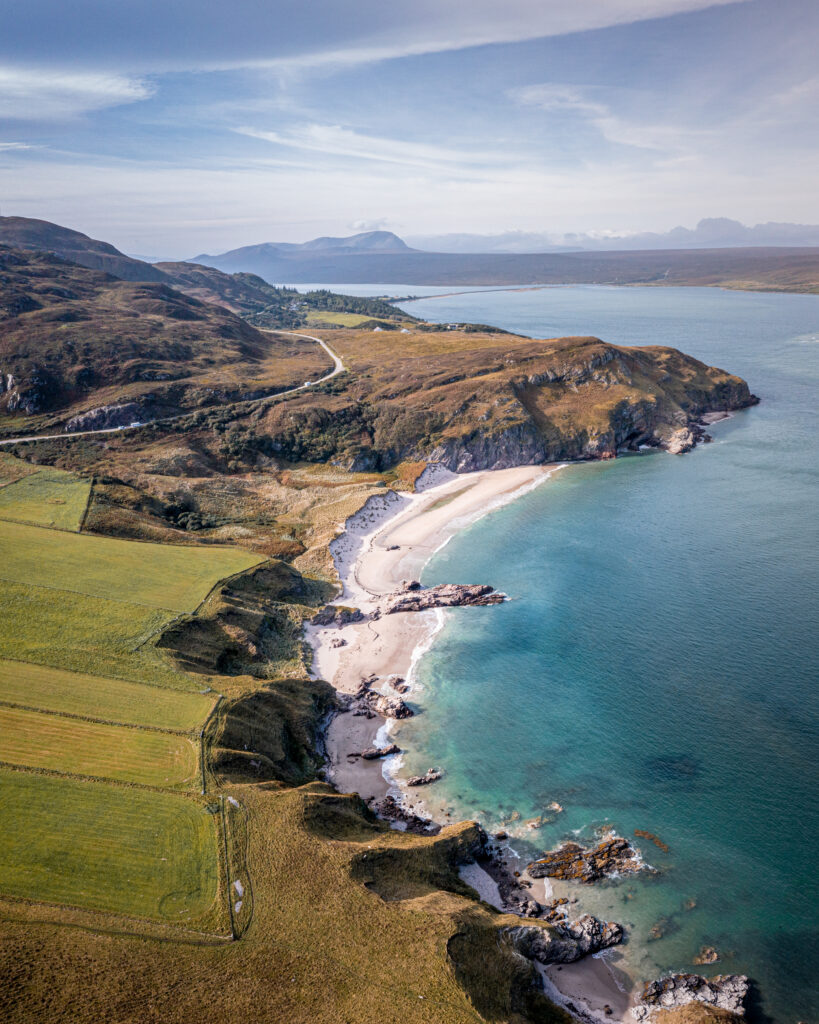
So there you have it, your guide to visiting castle Sinclair Girnigoe on the North Coast 500. If you have visited the NC500 recently, let us know what you thought of it!
As always, sharing is caring so make sure to share this guide with your family and friends and inspire them to head off on their own North Coast 500 adventure. If you are planning the trip for yourself, make sure you have a look at the rest of our Scotland content for more inspiration to our beautiful home country.
When you set off on your own adventure, be sure to tag us in your photos on Instagram and we will share them with the rest of our community. In the meantime, why not follow us over there to see what we are currently up to and keep up with us on our Instagram Stories.
Now Read:
This article may contain affiliate links that provide us with a small income. For more information read our Affiliate page.
Pin it for later!
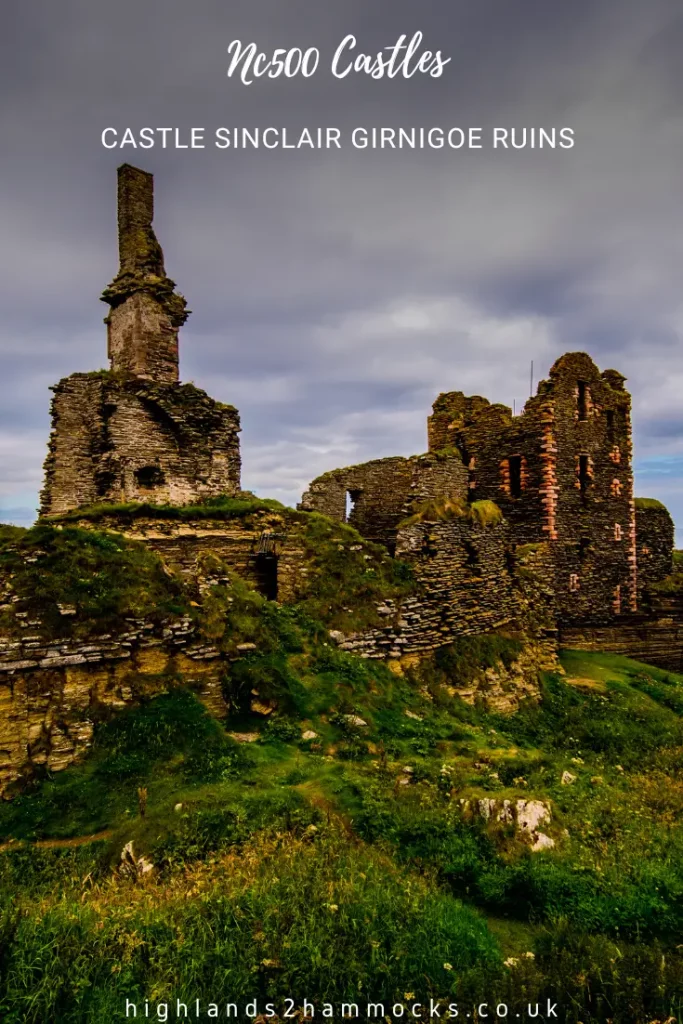
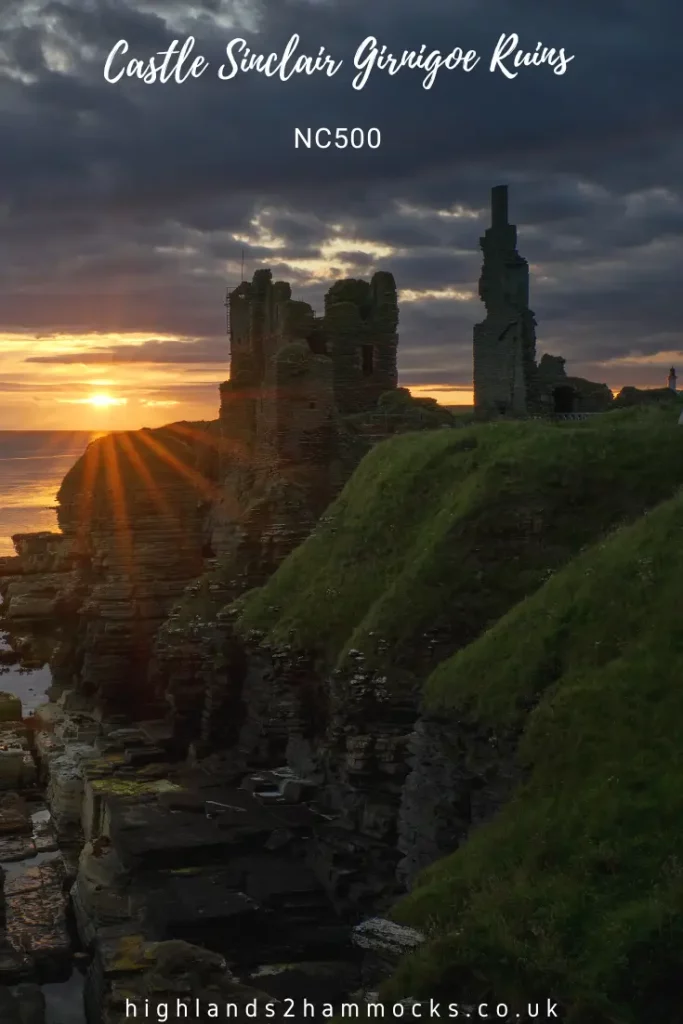

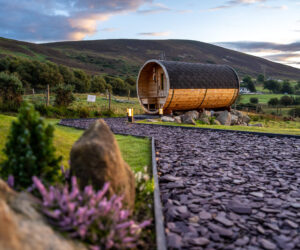
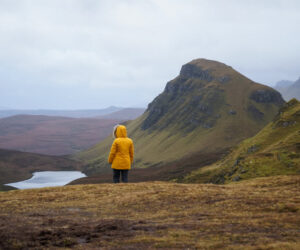
Pingback: North Coast 500 Castles - The Ultimate Guide to Scotland's Historical Castles | highlands2hammocks